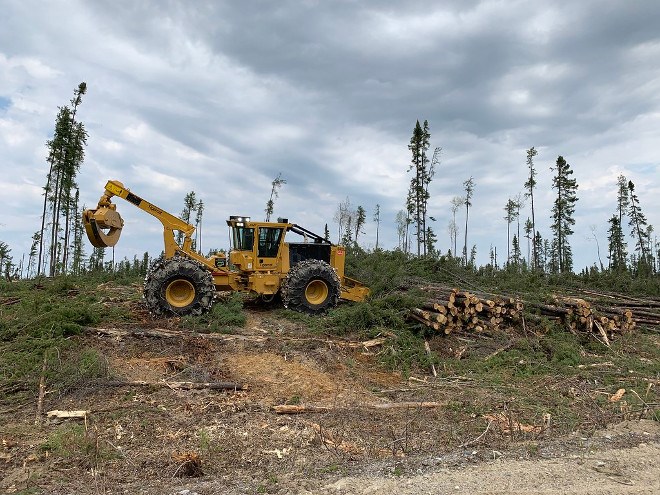Agoke Development Corporation (ADC) staged a showcase event in northwestern Ontario to allow mechanical harvesting suppliers and manufacturers to view First Nation trainees at work in the bush.
The corporation hosted Tigercat and Wajax Dealer representatives from Brantford, Hearst and Thunder Bay for a demonstration in the Ogoki Forest, 400 kilometres northeast of Thunder Bay, May 28.
ADC is a forestry company owned by the three First Nation communities of Aroland, Eabametoong and Marten Falls. The training program is a capacity-building exercise run through Confederation College in Thunder Bay.
In a May 29 corporation news release, 10 trainees from the communities showed off their skills on a feller buncher, skidder and harvesting processor.
Through Wajax’s Thunder Bay office, the program secured a Tigercat Buncher 845d, Skidder 632E and Harvester H822D, which were hauled up to the site in early May.
Trainer Brad Goliboski of Goliboski Contracting said the trainees have come a long way in a short period of time.
“There are operators out there, but they don’t have the kind of skills and experience we need for working in the rugged uplands and lowlands of the remote Ogoki Forest.”
He believes First Nations provide the solution to chronic labour shortages.
“We’re already working with First Nations in the region and we are very optimistic that they can have massive human capital potential. They live in the North and they have a vested interest in the land. They want the best for the environment, but they also want the economic benefit for their First Nation peoples.”
The three communities had an aspirational goal of obtaining a sustainable forest licence on the largely dormant 19,000-square-kilometre Ogoki Forest to do the harvesting and hauling to area mills.
That goal came to pass in the spring of 2018 with an historic two-year interim agreement with Ministry of Natural Resources and Forestry. It set the stage for negotiation of a long-term agreement.
Last summer, Agoke Lumber LP, an arm of the development corporation, signed a joint venture agreement with Buchanan Sawmills to supply the Nakina mill with fibre and put local lndigenous folks to work in the mill.
ADC board director Mark Bell of Aroland said the communities want to benefit from the spin-off opportunities that come with forest operations within their traditional territories.
“We view the regional forestry shortfall as a golden opportunity for our peoples. Obviously, there are many from Aroland, Eabametoong and Marten Falls already working in forestry but the goal now is to open the door wider and facilitate training.”
Eabametoong board director Bill Spade said Indigenous young people can fill the void, but for them to realize their true potential and carve out a career in forestry, a “holistic approach” must be devised by First Nations, government and industry on recruiting, training, internships, retention and advancement.
“These are all key pillars of the Agoke Joint Venture Agreement that we have in place with the Nakina sawmill.”
Marten Falls board director Lawrence Baxter echoed the proper supports must be put in place to produce a homegrown workforce of millwrights, saw filers, and electricians.
“We haven’t forgotten about pre-employment training, life skills, self-confidence building exercises, and wrap around support for retention. We are also looking to develop partnerships with businesses that involve First Nations peoples within their forest companies. This is core to Agoke’s procurement policies.”
The 10-week training program involves six weeks of classroom work with life skills and safety training modules.
Baxter also wants to see a strategy that mitigates the cost of on-the-job training.
“One recommendation is for Ontario to provide a tax-credit for contractors. This would ensure the next generation of workers acquire the knowledge to be safe and productive before the trade is lost to retirement.”
The Agoke news release quoted a 24-year-old trainee Dillon Atlookan from Eabametoong, who previously had no experience with mechanical harvesting equipment.
He was looking forward to getting on with a production crew and serving as a future leader to First Nation youth considering a career in forestry.
“I love working in the woods, on the traditional lands, I like working with the big machines, it’s easy. I have a great crew of people to work with."




